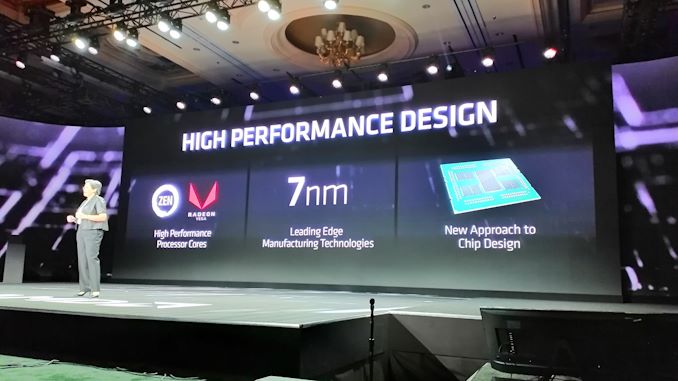AMD Pushing the AMD+AMD Strategy with Executive Promotions
by Ian Cutress on January 25, 2019 9:00 AM EST
Today AMD is announcing some realignment of its executive team along with some promotions. The idea behind the changes boils down to AMD wanting to focus its efforts on bringing the CPU and GPU strategy together, for future AMD+AMD combinations. The goal is that users should want to pair Ryzen with Radeon, or EPYC with Instinct, and by aligning the hierarchy behind that goal, it should be easier to manage and achieve.
There are several big announcements in AMD’s team today:
Darren Grasby, the long standing SVP of Global Computing and Graphics Sales will now become SVP and Chief Sales Officer, covering both consumer and enterprise, as well as becoming the President of AMD EMEA (Europe, Middle East, Africa). Darren has been at AMD over twelve years, and has been instrumental in the last couple of years for driving the adoption of Ryzen and Radeon as well as the sales message behind the product portfolio. His remit now covers all of AMD’s enterprise products, as well as the embedded products.
Dr. Sandeep Chennakeshu has been hired from his role as President of Blackberry Technology Solutions to become Executive Vice President of the Computing and Graphics group. Under this role he will manage the strategy, business, and engineering for AMD’s PC, graphics, and semi-custom product lines. Dr. Chennakeshu’s history includes time at Freescale (while Dr. Lisa Su was there), as well as President at Ericsson Mobile Platforms and CTO of Sony Ericsson.
Mark Papermaster, current SVP and CTO of AMD, is promoted to Executive Vice President. This is in recognition of his expanding role within AMD.
Forrest Norrod, SVP and GM of AMD’s Datacenter and Embedded Solutions Group, will now be in control of and have responsibility for both the EPYC and Radeon Instinct product lines.
The idea here is that AMD is going to push prioritize a synergy between Ryzen + Radeon or EPYC + Instinct across the company, leveraging on the success of partnering both sets of products together. In order to do this, it requires upper management to know what both sides are thinking, which is why we are seeing key employees now taking strategy and business roles covering both CPU and GPU product lines.










85 Comments
View All Comments
dgingeri - Friday, January 25, 2019 - link
I like AMD's processors, that's for sure, but I won't even consider their graphics cards anymore. I had three, before they were owned by AMD, and had horrible experiences with their drivers because of it, from my old ATI Rage Fury MAXX, where driver support was never fully realized and then ended early, to my Radeon 9700, where the drivers would crash my system daily for the year I had it, to my Radeon 4870X2, where, again, driver support was never realized and then ended early. I have not read enough to convince me to try again.cwolf78 - Friday, January 25, 2019 - link
You do realize their drivers have been entirely re-written since then, right?willis936 - Friday, January 25, 2019 - link
If you look at how RTG has consistently stayed far behind Nvidia there is little reason to think things have improved in the past decade. I would really like them to, but unless mommy Lisa really digs into RTG I don't see things improving on their own.Opencg - Friday, January 25, 2019 - link
well nvidias prices went up 75% for an 18% performance increase. and those prices cant magically go down the chips actaully cost more to make. meanwhile amd is about to release the most cost effective chips ever.nevcairiel - Friday, January 25, 2019 - link
And yet their Radeon 7 offers 2080 performance for a 2080 price.emn13 - Friday, January 25, 2019 - link
That's a wild stab in the dark. There aren't any independent reviews, and no street prices - you have no idea about both sides of your statement there.jeremyshaw - Friday, January 25, 2019 - link
That's AMD's own claim.nevcairiel - Friday, January 25, 2019 - link
AMDs own numbers pit it straight against the 2080. Never have I seen a first party benchmark undershooting the actual performance.nevcairiel - Friday, January 25, 2019 - link
AMDs own benchmark numbers pit it about equal against the 2080. First party benchmarks being worse then reality would be a first.Samus - Sunday, January 27, 2019 - link
As with everything AMD, it depends what programs and games you run. Most applications favor Intel, and about half of games favor nVidia. But if you do a lot of compression\decompression, number crunching or FPU heavy tasks, AMD CPU's are generally superior for the money. And if you play games optimized for Mantle or are simply from a dev that favors AMD's architecture, AMD is, again, the better value.As far as drivers and shit go, I'd say since Catalyst was axed in favor of Crimson, they are on-par with nVidia driver development. AMD's biggest problem with their GPU's is their partner program sucks. They don't have anybody like EVGA or PNY to make great quality performance and reference cards at a value price. Saphire is a joke and the third party providers (which are usually cross platform licensees - they also build nVidia cards) are very run-of-the-mill, especially MSI, Gigabyte and Asus - who subjectively always have unreliable long-term coolers.
This partner problem AMD has results in lost OEM presence.